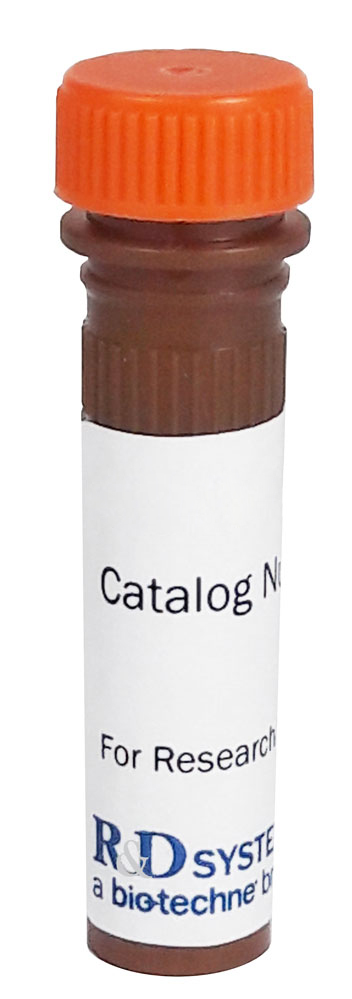Mouse CD40 Ligand/TNFSF5 Alexa Fluor® 488-conjugated Antibody
Mouse CD40 Ligand/TNFSF5 Alexa Fluor® 488-conjugated Antibody Summary
Glu61-Leu260
Accession # P27548
Applications
Please Note: Optimal dilutions should be determined by each laboratory for each application. General Protocols are available in the Technical Information section on our website.
Reconstitution Calculator
Preparation and Storage
Background: CD40 Ligand/TNFSF5
CD40 ligand (CD40L; also known as CD154, TNFSF5, TRAP, or gp39) is a 260 amino acid (aa) type II transmembrane glycoprotein belonging to the TNF family. Mouse CD40L consists of a 22 aa cytoplasmic domain, a 24 aa transmembrane domain, and 214 aa extracellular domain bearing a single glycosylation site (1, 2). CD40L is expressed predominantly on activated CD4+ T lymphocytes and also found in other types of cells, including NK cells, mast cells, basophils, and eosinophils. Murine CD40L shares 78% amino acid sequence identity with human CD40L. Native bioactive soluble CD40L exists. Soluble human trimeric CD40L secreted by stimulated T cells has been shown to be generated by proteolysis in the microsomes (3). Both membrane bound and soluble CD40L induce similar effects on B cells (3, 4). The receptor of CD40L is CD40, a type I transmembrane glycoprotein belonging to the TNF receptor family. CD40 is expressed on B lymphocytes, monocytes, dendritic cells, and thymic epithelium. Although all monomeric, dimeric, and trimeric forms of soluble CD40L can bind to CD40, the soluble trimeric form of CD40L has the most potent biological activity through oligomerization of cell surface CD40, a common feature of TNF receptor family members (2). The genetic defect in the hyper-IgM syndrome is due to point mutations or deletions of the gene encoding the CD40L, which prevent CD40L from interacting with CD40 (5‑7). CD40L mediates a range of activities on B cells including induction of activation-associated surface antigen, entry into the cell cycle, isotype switching, Ig secretion, and memory generation (8, 9). CD40-CD40L interaction also plays important roles in monocyte activation and dendritic cell maturation (10).
- Armitage, R.J. et al. (1992) Nature 357:80.
- Hollenbaugh, D. et al. (1992) EMBO J. 11:4313.
- Fabienne, P. et al. (1996) J. Biol. Chem. 271:5965.
- Fabienne, P. et al. (1996) Eur. J. Immunol 26:725.
- Arrufo, A. et al. (1993) Cell 72:291.
- Hill, A. and N. Chapel et al. (1993) Nature 361:494.
- Korthauer, U. et al. (1993) Nature 361:539.
- Spriggs, M.K. et al. (1992) J. Exp. Med. 176:1543.
- Fanslow, W.C. et al. (1994) Seminars in Immunology 6:267.
- Kooten, C.V. and J. Banchereau (2000) J. Leukoc. Biol. 67:2.
Product Datasheets
Product Specific Notices
This product is provided under an agreement between Life Technologies Corporation and R&D Systems, Inc, and the manufacture, use, sale or import of this product is subject to one or more US patents and corresponding non-US equivalents, owned by Life Technologies Corporation and its affiliates. The purchase of this product conveys to the buyer the non-transferable right to use the purchased amount of the product and components of the product only in research conducted by the buyer (whether the buyer is an academic or for-profit entity). The sale of this product is expressly conditioned on the buyer not using the product or its components (1) in manufacturing; (2) to provide a service, information, or data to an unaffiliated third party for payment; (3) for therapeutic, diagnostic or prophylactic purposes; (4) to resell, sell, or otherwise transfer this product or its components to any third party, or for any other commercial purpose. Life Technologies Corporation will not assert a claim against the buyer of the infringement of the above patents based on the manufacture, use or sale of a commercial product developed in research by the buyer in which this product or its components was employed, provided that neither this product nor any of its components was used in the manufacture of such product. For information on purchasing a license to this product for purposes other than research, contact Life Technologies Corporation, Cell Analysis Business Unit, Business Development, 29851 Willow Creek Road, Eugene, OR 97402, Tel: (541) 465-8300. Fax: (541) 335-0354.
FAQs
No product specific FAQs exist for this product, however you may
View all Antibody FAQsReviews for Mouse CD40 Ligand/TNFSF5 Alexa Fluor® 488-conjugated Antibody
There are currently no reviews for this product. Be the first to review Mouse CD40 Ligand/TNFSF5 Alexa Fluor® 488-conjugated Antibody and earn rewards!
Have you used Mouse CD40 Ligand/TNFSF5 Alexa Fluor® 488-conjugated Antibody?
Submit a review and receive an Amazon gift card.
$25/€18/£15/$25CAN/¥75 Yuan/¥2500 Yen for a review with an image
$10/€7/£6/$10 CAD/¥70 Yuan/¥1110 Yen for a review without an image



